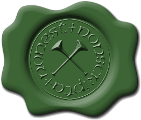
| Home | FAQs | Rules | Archives | Articles | Jobs | Links | KWHSS | OSCAR | SCA.org |
An Essay on Seme
by Eowyn Amberdrake
The Word Perfect document
In the series " A Return to First Principles", Roger F. Pye addresses the topic of seme in his third essay. He starts with the statement that seme is not normally depicted in English Armory in the "cut from cloth" style. Aside from France Ancient, great care was taken by early engravers to not cut off or obscure the seme charges. These statements were by way of introduction to his main thesis, that is, that more than six charges is seme, and that counting the charges, or even (horrors!) enshrining in the blazon their placement on the shield is contrary to the true soul of heraldry. It is the later thesis he discusses for the remaining three-quarters of the article.
I have no quarrel at all with the "don't count 'em, draw as many as will fit" interpretation of "how many is semy?". However, many in the Society have interpreted his statement about "normal English practice" to mean that only France Ancient was ever drawn in period in the "cut from cloth" style, and it is with that interpretation that I must differ.
Seme fields were in fact occasionally drawn in period with the seme charges cut off at the edges, both in England and elsewhere. The clearest English examples that I have found are in the Rous Roll: arms of Rohand, Earl of Warwick (see Figure 1): Gules, crussily botonny Or. These arms are quartered, still in the "cut from cloth" style, throughout the listing of his descendents in the Roll. For instance, Figure 2 shows Dame Felys and Sir Guy, Earl of Warwick. Crosses were not the only charge so treated. Figure 3 shows the drawing of the arms of Elfied, daughter of Alfred the Great. The first quarter is blazoned "azure, seme of martlets Or."
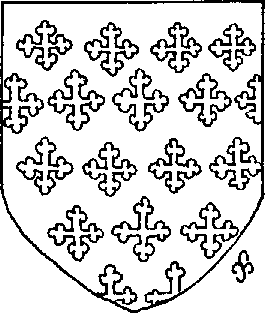
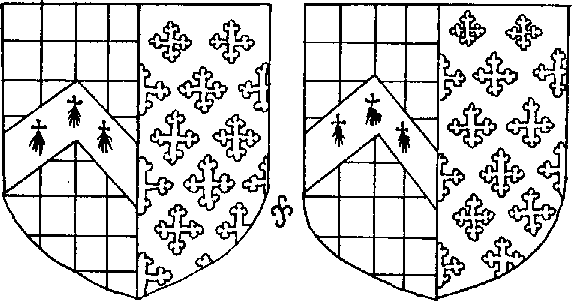
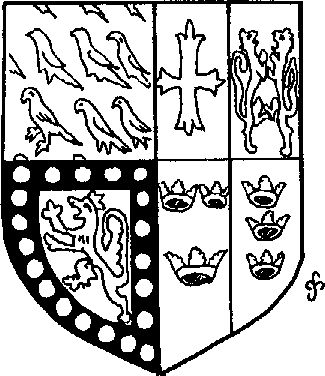
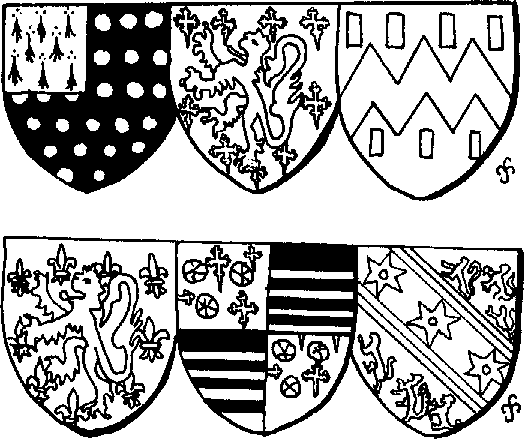
Several bordures are charged with an unspecified number of charges (horseshoes or plates). The given blazon just say "a bordure azure charged with horseshoes" or "charged with plates". Only whole charges are drawn, and the number varies with the size of the quartering, but while we would undoubtedly blazon the bordures as "semy", they were not so blazoned (not even as "a bordure platey") in this Roll.
The history of the Earls of Warwick was written by John Rows about 1483. It was prepared for publication in 1845 and has just been reissued in 1980. One of the most useful aspects of this source is that it has both exact renderings of period illustrations and period blazons. Many sources have one or the other, but not both.
My research has revealed three distinct ways of drawing seme charges, which styles I have called "whole". "cut from cloth" and "mixed". Figure 4 shows examples of all three kinds of semy. It is from An Outline of British Heraldry and is a reprint of a page from Armorial de la Toison d'Or et de l'Europe, which is from about the early 1400's. Ignoring France Ancient in Beaumont, I counted this as 2 "whole" (de Demkou, de Sontse, 1 "cut from cloth" (Dersy) and 1 "mixed" (de la Ware).
Table 1 is a chart of the period
drawings of seme charges that I found. Date is the probable date
of the manuscript; the blazon is either done by me or given
in the text; the style is one of "whole charges", "cut from
cloth" or a "mixture" of the two; the semy charges are shown either
on a field or a bordure, the number of instances of semy
seen; the illustration I was working with was either R (redrawn)
or O (original photo); the powdered charges were . . .; refers
to the listing in the bibliography, then page number.
Table 1: Period Instances of Semy
|
|
|
Me Glv |
Wl Cut Mix |
Fld Brd |
|
R O |
|
|
| Archb, Scrope | ? | x | x | x | 1 | x | mitres | 13 |
| Henry Blurchler | ? | x | x | x | 1 | x | billets | 6,299 |
| Paris Roll | 1244 | x | x | x | 2 | x | roundels | 3 |
| Dering Roll | 1275 | x | x | x | 2 | x | crosses | 14 |
| Wijnbergen Arm | <1291 | x | x | x | 1 | x | billets | 8 |
| Wijnbergen Arm | <1291 | x | x | x | 1 | x | martlets | 8 |
| Richard of Corn. | 1290 | x | x | x | 1 | x | roundels | 8 |
| Walther von Kll | 1300 | x | x | x | 3 | x | billets | 5 |
| Maniple broidery | <1350 | x | x | x | 1 | x | mrt,r,h,shoes | 3 |
| Powell's Roll | 1350 | x | x | x | 1 | x | crosses | 6,89 |
| Arm, de Geire | 1386 | x | x | x | 1 | x | billets | 8 |
| Garter Stall Pl. | 1396 | x | x | x | 1 | x | fleurs | 6,89 |
| Flag: de Blonay | <1400 | x | x | x | 1 | x | crosses | 8 |
| a romance | <1400 | x | x | x | 5 | x | fleurs | 1 |
| Bruce Garter Bk | 1430 | x | x | x | 2 | x | crowns, flrs | 8 |
| Thom. Jenyn's | 1440 | x | x | x | 1 | x | stars, bez. | 4 |
| Thom. Jenyn's | 1440 | x | x | x | 1 | x | roundels | 14 |
| Portcullis Bk | 1440 | x | x | x | 2 | x | roundels | 14 |
| Arm. Tolson d'Or | <1450 | x | x | x | 1 | x | billets, ronds | 7 |
| Arm. Tolson d'Or | <1450 | x | x | x | 1 | x | crosses | 7 |
| Arm. Tolson d'Or | <1450 | x | x | x | 1 | x | crosses | 7 |
| Wrythe Garter | 1480 | x | x | x | 1 | x | crosses | 4 |
| Peter le Neve R | 1480 | x | x | x | 2 | x | crosses | 6,89 |
| Rows Roll | 1483 | x | x | x | 3 | x | cros, martlet | 12 |
| Rows Roll | 1483 | x | x | x | 1 | x | roundels | 12 |
| Rows Roll | 1483 | x | x | x | 1 | x | crosses | 12 |
| Boke of St. Albans | 1486 | x | x | x | 2 | x | crosses | 9 |
| Boke of St. Albans | 1486 | x | x | x | 1 | x | roundels | 9 |
| Jasper Tudor Seal | <1495 | x | x | x | 1 | x | martlets | 6,496 |
| Jorg Rugenn | 1495 | x | x | x | 2 | x | fleurs | 8 |
| Pr. Arthur's Boo | <1519 | x | x | x | 1 | x | suns, fleurs | 2 |
| Cloth of Gold Score | 1520 | x | x | x | 1 | x | eagles | 4 |
| Cloth of Gold | 1520 | x | x | x | 1 | x | France mod | 4 |
| Dom Fernando | 1530 | x | x | x | 1 | x | Castile | 11 |
| Scot Armorial | 1591 | x | x | x | 1 | x | heaqrts | 8 |
France Ancient is specifically not included. I have restricted myself to pictures of original sources and redrawings of original sources in which care for accurate representation of the original seems to have been the goal.
My conclusions from this admittedly limited data are:
- 1. A bordure semy has an
uncounted number of whole charges, and the blazoning style of "charged
with whatever" clearly conveys this to both herald and artist. Note that
this blazon style implies that in this case semy is treated as charges,
not as a treatment of the field.
2. A field with charges semy may be drawn any of the following ways;
- A. As small whole charges
B. As if cut from cloth; the artist carefully puts small parts of charges at the edges of the field.
C. In a combination; the artist tries for whole charges, but if the edges of the shield get in the way, or the main charge gets too flamboyant, then cut off the charges as needed.
3. Our Society view of semy is schizophrenic: the rules call it a treatment of the field, but the mandated drawing style is solely that of small whole charges.
B. The Rules for Submission should not mandate any particular drawing style for semy fields.
C. Seme charges are still charges, not part of the field. However, whether or not it is drawn from "cut from cloth" they should not add to the "thickness" or number of layers in the device. This is because it can be drawn without adding these "thicknesses" so we should not penalize the submittor for his artist's chosen style.
Table 2: Examples of France Ancient Used as a Bordure
(All blazons given)
| Source | Style
Wl Cut Mix |
Date | Ref |
| John of Eltham Tomb | x | 1336 | 6,493 |
| John of Holland seal | x | 1381 | 6,493 |
| John de Holland seal | x | 1381-1455 | 6,493 |
| Henry de Holand seal | x | 1455 | 6,493 |
| Willement's Roll | x | 1392 | 14 |
Table 3 Summary of Bordures
|
|
|
|
|
|
|
|
|
|
|
|
|
|
|
|
|
|
||
|
|
|
|
|
|
|
|
|
|
|
|
|
|
|
|
|
|
|
|
|
|
|
|
|
|
|
|
|
|
Bibliography
2. Brooke-Little, J.P., Royal Heraldry, Beasts and Badges of Britain, Pilgrim Press, Ltd., 1981
3. Child, Heather, Heraldic Design, Genealogical Publishing Co., Inc., Baltimore, 1982
4. Dennys, Rodney, The Heraldic Imagination, Crown Publishers, New York, 1975.
5. Die Minnesinger, in Bildern der Manessischen Handschrift, H. F. Hutte, Leipzig, no printing date
6. Fox-Davies, A.C., A Complete Guide to Heraldry, Bonanza Books, 1978
7. Innes-Smith, Robert, An Outline Guide of Heraldry in England and Scotland, Pilgrim Press, Ltd., Derby, 1980
8. Neubecker, Ottfried, Heraldry: Sources, Symbols and Meaning, McGraw-Hill Book Co., 1976
9. Proceedings of the Caerthan Heraldry Symposium, Denver, 1981
10. Pye, Roger F. "Return to First Principles: III --- Semy", Coat of Arms, VII (1953), pp. 206-208.
11. Renaissance Painting in Manuscripts, Treasures from the British Library, Hudson Hills Press, New York, 1983.
12. Rous, John, The Rous Roll, Alan Sutton, Gloucester, 1980>
13. Shields in York Minster, Woodcock and Pearson, York, no printing date
14. Wright, C.E., English heraldic Manuscripts in the British Museum, British Museum Publications, 1973
The heraldry.sca.org site is copyright 1995-2024 Society for Creative Anachronism, Inc. The copyright of certain portions of heraldry.sca.org are retained by the original contributors as noted.
External links are not part of the heraldry.sca.org web site. Inclusion of a page or site here is neither implicit nor explicit endorsement of the site. Further, SCA, Inc. is not responsible for content outside of heraldry.sca.org. For information on how SCA uses collected and submitted data, please see the Privacy Policy.
Paper texture used with permission from GRSites.com.